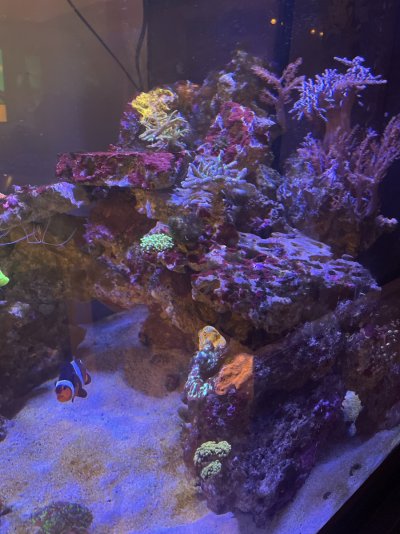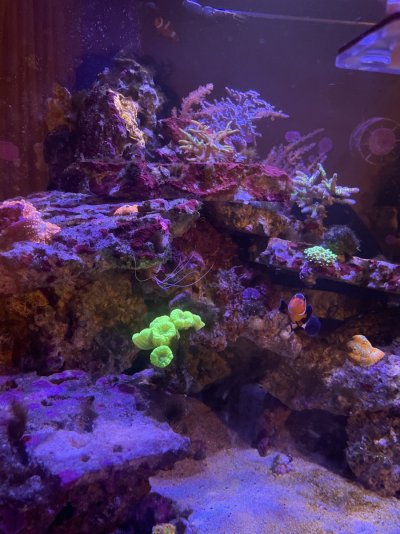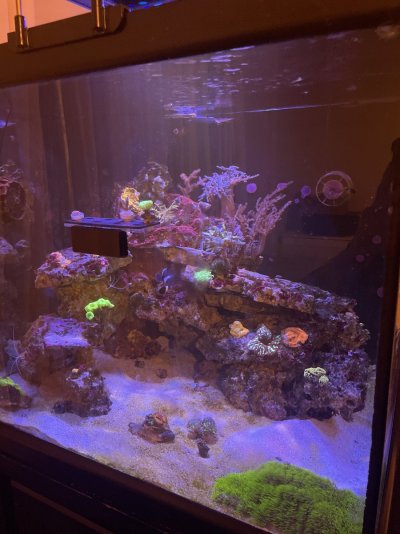I used the Caribsea Aragonite in my build thats on-going at the moment, and it took me close to 1.5 hours per bag to clean it up!40lbs of caribsea aragonite special grade dry sand arrived. First 20lbs or so being rinsed in a bucket. Just pouring the sand from bag into bucket there were clouds of dust. Put hose at bottom of 5g bucket and poured a few cups of sand in, then put smaller bucket lid over hose and sand, then added much more sand on top until about half the sand bag was in bucket. Turned on water slowly, raised flow, saw lots of silty water coming out.
Ran for ~15m, water clear, but I see most water from sand is coming up from one spot. Going to drain the water, transfer sand and hose to 2nd bucket and start a 2nd rinse.
Navigation
Install the app
How to install the app on iOS
Follow along with the video below to see how to install our site as a web app on your home screen.
Note: This feature may not be available in some browsers.
More options
You are using an out of date browser. It may not display this or other websites correctly.
You should upgrade or use an alternative browser.
You should upgrade or use an alternative browser.
Official Sand Rinse and Tank Transfer thread
- Thread starter brandon429
- Start date
- Tagged users None
On 3rd 10m+ rinse w/ ~20lbs in 5g bucket. Definitely plenty more fine-grained stuff coming out. Liking the bucket to bucket method, but unsure changing every 10m is doing that much. Will likely let this one run for 20m or so then cover it outside until next batch of rinses tomorrow.
@JonoH Did you rinse your sand w/ RO afterwards?
@JonoH Did you rinse your sand w/ RO afterwards?
I didnt, but only due to the volume of my tank, i let the sand dry out before i put it into the tank, and its close to 1000L (220 Gal), so i figured if there was anything it would be so diluted it wouldnt really make a difference.On 3rd 10m+ rinse w/ ~20lbs in 5g bucket. Definitely plenty more fine-grained stuff coming out. Liking the bucket to bucket method, but unsure changing every 10m is doing that much. Will likely let this one run for 20m or so then cover it outside until next batch of rinses tomorrow.
@JonoH Did you rinse your sand w/ RO afterwards?
Also it would have taken a ton of RO as i had 12 bags to to through!
I didnt, but only due to the volume of my tank, i let the sand dry out before i put it into the tank, and its close to 1000L (220 Gal), so i figured if there was anything it would be so diluted it wouldnt really make a difference.
Also it would have taken a ton of RO as i had 12 bags to to through!
I just found this thread again after tossing up whether I go the cleaning route or not (have always done it previously but have seen a bunch of videos etc on YT in recent time where they don't even bother and just wait for the cloudiness to dissipate), can't believe it's 12 bags you went through. I'm pretty sure I'm wanting a similar sandbed to what you've got so now I'm definitely thinking my 5 bags is going to do sweet stuff all LOL
I don't remember ever rinsing my sand with ro previously, could've done but not sure and like yourself I'm thinking I might just skip that because given the size of the system, I think it'll be diluted enough to deal with a small amount of tap water.
Not looking forward to the cleaning process but I'm sure I'll appreciate having a clear tank once it's done. *sigh
It was worth the time spent!I just found this thread again after tossing up whether I go the cleaning route or not (have always done it previously but have seen a bunch of videos etc on YT in recent time where they don't even bother and just wait for the cloudiness to dissipate), can't believe it's 12 bags you went through. I'm pretty sure I'm wanting a similar sandbed to what you've got so now I'm definitely thinking my 5 bags is going to do sweet stuff all LOL
I don't remember ever rinsing my sand with ro previously, could've done but not sure and like yourself I'm thinking I might just skip that because given the size of the system, I think it'll be diluted enough to deal with a small amount of tap water.
Not looking forward to the cleaning process but I'm sure I'll appreciate having a clear tank once it's done. *sigh
I had close to no cloud in the tank at all, the only time it got a little mirky was when the first water was added in, and it was clear an hour later.
I have some algea growing on my sand bed now, but its nothing you wouldnt expect with a new tank as it balances, so i dont think not rinsing it made a different at all.
Hopefully yours is cleaner than mine was, it took ages! (Or at least...took my Son ages hahah)
Well 3hrs trying to clean 2x 20lb bags of sand at once In a 35ltr bucket. What a failure.
Ridiculous that after all this time it's still not running clear... looked close to clear at one stage so I gave it a good mix up again expecting it shouldn't be too much longer... nope..
Is there a trick to this I'm missing??
Hose in bucket tucked under the sand.. what more is there lol
Ridiculous that after all this time it's still not running clear... looked close to clear at one stage so I gave it a good mix up again expecting it shouldn't be too much longer... nope..
Is there a trick to this I'm missing??
Hose in bucket tucked under the sand.. what more is there lol
Do it in small sections, like 1/3 of a bag at a time - that seemed to make it quicker.Well 3hrs trying to clean 2x 20lb bags of sand at once In a 35ltr bucket. What a failure.
Ridiculous that after all this time it's still not running clear... looked close to clear at one stage so I gave it a good mix up again expecting it shouldn't be too much longer... nope..
Is there a trick to this I'm missing??
Hose in bucket tucked under the sand.. what more is there lol
You really need to blast it to get all the dust/loose particles to seperate from the sand.
My first bag i did all in one go, and it took close to 2 hours, by doing smaller sections it goes a lot faster.
Thanks mate I'll give that a go tonight!Do it in small sections, like 1/3 of a bag at a time - that seemed to make it quicker.
You really need to blast it to get all the dust/loose particles to seperate from the sand.
My first bag i did all in one go, and it took close to 2 hours, by doing smaller sections it goes a lot faster.
Hello everyone, first ever post on this forum! I’ll try and make it count. Thanks in advance for your help.
So I read through the 59 pages of this thread, incredible information. Some of it seems counter intuitive to me, but I have very little experience so my opinion probably isnt worth much.
Little bit of history:
So I bought my tank about 1 year and a half ago, first ever salt water aquarium, bought it with a fox face, hippo tang, 2 clowns and a chromis. Its a 90g cube aquarium that had been neglected for a while (had been running for about 7 years at the previous owner’s).
I had never owned a saltwater let alone move one. Let me tell you it was quite an experience to deal with. Anyway with the best of my abilities and limited knowledge I was able to save all the fish and the coral (kenya tree) which I was pretty proud of.
Then the fun and learning curve began. I thought the majano were zoa .. I feed them reef roids for a few weeks.. I learned what vermatid snails were, I learned what aptasias looked like. I learned how a skimmer works and so much more. I ended up loosing the tangs and the chromis about 8 months after the move, the clowns are still doing well (as far as I can tell)
I will try and keep this as short as possible (still wont be short so i’m sorry, but so thankful for the help)
Fast forward to a year and a half later (today) I want to change from my 90g cube to a 135g (72"x20"x24" roughly) because although it is bigger the shape of the tank will be less bulky in the room as the cube takes almost 40" depth.
Before I get into the actual tank transfer I have questions
1: my rocks have some vermatid snails, and I got the hair algea mostly under control but still have some. Is there a way to re use my rocks without bringing along all the undesirables?
2: I have a pretty shallow sandbed, and considering I did pretty much everything that brandon says to avoid and was "successful" in my first move, I’m wondering if it could be doable to use the sand (extensively rinsed with salt water) to "seed" new dry rocks into the new tank. I have been moving it around in the last year and syphoned it often too.
3: Is there a way for me to limit the cycle in the new tank, or am I being impatient and cheap and I should just cycle new rocks/sand and be done with it
Lets start there and hopefully build some knowledge in me.
Thank you again everyone that made it this far into my rambling! I’m all ear for your suggestions/help/concerns/insults (hopefully not)
Cheers

So I read through the 59 pages of this thread, incredible information. Some of it seems counter intuitive to me, but I have very little experience so my opinion probably isnt worth much.
Little bit of history:
So I bought my tank about 1 year and a half ago, first ever salt water aquarium, bought it with a fox face, hippo tang, 2 clowns and a chromis. Its a 90g cube aquarium that had been neglected for a while (had been running for about 7 years at the previous owner’s).
I had never owned a saltwater let alone move one. Let me tell you it was quite an experience to deal with. Anyway with the best of my abilities and limited knowledge I was able to save all the fish and the coral (kenya tree) which I was pretty proud of.
Then the fun and learning curve began. I thought the majano were zoa .. I feed them reef roids for a few weeks.. I learned what vermatid snails were, I learned what aptasias looked like. I learned how a skimmer works and so much more. I ended up loosing the tangs and the chromis about 8 months after the move, the clowns are still doing well (as far as I can tell)
I will try and keep this as short as possible (still wont be short so i’m sorry, but so thankful for the help)
Fast forward to a year and a half later (today) I want to change from my 90g cube to a 135g (72"x20"x24" roughly) because although it is bigger the shape of the tank will be less bulky in the room as the cube takes almost 40" depth.
Before I get into the actual tank transfer I have questions
1: my rocks have some vermatid snails, and I got the hair algea mostly under control but still have some. Is there a way to re use my rocks without bringing along all the undesirables?
2: I have a pretty shallow sandbed, and considering I did pretty much everything that brandon says to avoid and was "successful" in my first move, I’m wondering if it could be doable to use the sand (extensively rinsed with salt water) to "seed" new dry rocks into the new tank. I have been moving it around in the last year and syphoned it often too.
3: Is there a way for me to limit the cycle in the new tank, or am I being impatient and cheap and I should just cycle new rocks/sand and be done with it
Lets start there and hopefully build some knowledge in me.
Thank you again everyone that made it this far into my rambling! I’m all ear for your suggestions/help/concerns/insults (hopefully not)
Cheers
Attachments
Thank you for making your first post here! Welcome to reef2reef
indeed, rinsing out a reef tanks sandbed with tap water isn’t usual but it gives the consistency we get here for these years.
but it gives the consistency we get here for these years.
heres my answers:
1. before you do the big move/upgrade job take out a test rock with attachments on it you don’t want, and sit it on the counter
take a knife, not any other tool but a knife, and use the tip to scrape away algae and be exacting, work around corals etc. debride and rasp off all the algae, rinse it away with saltwater.
then when the area is made clean by scraping in detail, rinse off that cleaned section with peroxide and let it sit a couple minutes. This isn’t a dip, we never dip anything here, this is spot application of peroxide on areas that formerly had targets but you cleaned them off with a knife and saltwater rinsing first. No peroxide goes on algae, it goes on cleaned areas you detailed that used to have algae
algae is handled this way, vermitids will just grow back. You can search the forum for vermitid tricks, they’re hard to beat. I can’t beat them in my system.
2. rinsed sand made safe isn’t any type of seed. It’s just plainly rinsed 100% cloudless so that it’s neutral and can’t cause any cycling issues by clouding. Any dry rock you want to add just goes into the new tank, alongside the old rocks you cleaned and moved. the new rocks uptake bacteria by being in the tank alongside the other rocks, no seeding is needed. Your old rocks carry all the bacteria you’ll need anyway.
3. if you aren’t using any old rocks at all, then you should cycle the rocks well before the move job in a brute trash can and verify they are ready before being made the sole rocks in the new tank. You should not toss the old rocks. Clean them, move them all over - new rock will give you uglies that lasts a long time and old rocks cleaned off are what comprises this whole thread, no cycling happened. If you must use all new rocks and no old ones then simply have all the new rocks ready ahead of time.
indeed, rinsing out a reef tanks sandbed with tap water isn’t usual
heres my answers:
1. before you do the big move/upgrade job take out a test rock with attachments on it you don’t want, and sit it on the counter
take a knife, not any other tool but a knife, and use the tip to scrape away algae and be exacting, work around corals etc. debride and rasp off all the algae, rinse it away with saltwater.
then when the area is made clean by scraping in detail, rinse off that cleaned section with peroxide and let it sit a couple minutes. This isn’t a dip, we never dip anything here, this is spot application of peroxide on areas that formerly had targets but you cleaned them off with a knife and saltwater rinsing first. No peroxide goes on algae, it goes on cleaned areas you detailed that used to have algae
algae is handled this way, vermitids will just grow back. You can search the forum for vermitid tricks, they’re hard to beat. I can’t beat them in my system.
2. rinsed sand made safe isn’t any type of seed. It’s just plainly rinsed 100% cloudless so that it’s neutral and can’t cause any cycling issues by clouding. Any dry rock you want to add just goes into the new tank, alongside the old rocks you cleaned and moved. the new rocks uptake bacteria by being in the tank alongside the other rocks, no seeding is needed. Your old rocks carry all the bacteria you’ll need anyway.
3. if you aren’t using any old rocks at all, then you should cycle the rocks well before the move job in a brute trash can and verify they are ready before being made the sole rocks in the new tank. You should not toss the old rocks. Clean them, move them all over - new rock will give you uglies that lasts a long time and old rocks cleaned off are what comprises this whole thread, no cycling happened. If you must use all new rocks and no old ones then simply have all the new rocks ready ahead of time.
Thank you very much for the fast reply!Thank you for making your first post here! Welcome to reef2reef
indeed, rinsing out a reef tanks sandbed with tap water isn’t usualbut it gives the consistency we get here for these years.
heres my answers:
1. before you do the big move/upgrade job take out a test rock with attachments on it you don’t want, and sit it on the counter
take a knife, not any other tool but a knife, and use the tip to scrape away algae and be exacting, work around corals etc. debride and rasp off all the algae, rinse it away with saltwater.
then when the area is made clean by scraping in detail, rinse off that cleaned section with peroxide and let it sit a couple minutes. This isn’t a dip, we never dip anything here, this is spot application of peroxide on areas that formerly had targets but you cleaned them off with a knife and saltwater rinsing first. No peroxide goes on algae, it goes on cleaned areas you detailed that used to have algae
algae is handled this way, vermitids will just grow back. You can search the forum for vermitid tricks, they’re hard to beat. I can’t beat them in my system.
2. rinsed sand made safe isn’t any type of seed. It’s just plainly rinsed 100% cloudless so that it’s neutral and can’t cause any cycling issues by clouding. Any dry rock you want to add just goes into the new tank, alongside the old rocks you cleaned and moved. the new rocks uptake bacteria by being in the tank alongside the other rocks, no seeding is needed. Your old rocks carry all the bacteria you’ll need anyway.
3. if you aren’t using any old rocks at all, then you should cycle the rocks well before the move job in a brute trash can and verify they are ready before being made the sole rocks in the new tank. You should not toss the old rocks. Clean them, move them all over - new rock will give you uglies that lasts a long time and old rocks cleaned off are what comprises this whole thread, no cycling happened. If you must use all new rocks and no old ones then simply have all the new rocks ready ahead of time.
1: I will 100% do that tomorrow with a small rock that I have. The algea is bugging me more than the vermatid, although not very attractive, they aren’t as ugly as a big patch of hair algea. will update before/after pictures!
2: from my limited experience I found that it is a lot easier to work a new aquascape and glue rocks together when everything is dry. So I would like to add some dry rock into the new system. Anything that is dry and "waste free" should work right? My understanding from all my reading here is that you want to avoid transferring waste of any form into the new tank, so nothing with dead organisms in it!?
3: i’m not on a hurry and I want this to be done right, but I would also not mind to be able to skip a new full cycling of the rocks if I dont have to go through it. So mixing my existing cycled rocks with new one seems like its worth the effort!
Will definitely keep posting here.
Happy new year to you
Alright @brandon429, I did what you mentioned in your previous message.Thank you very much for the fast reply!
1: I will 100% do that tomorrow with a small rock that I have. The algea is bugging me more than the vermatid, although not very attractive, they aren’t as ugly as a big patch of hair algea. will update before/after pictures!
2: from my limited experience I found that it is a lot easier to work a new aquascape and glue rocks together when everything is dry. So I would like to add some dry rock into the new system. Anything that is dry and "waste free" should work right? My understanding from all my reading here is that you want to avoid transferring waste of any form into the new tank, so nothing with dead organisms in it!?
3: i’m not on a hurry and I want this to be done right, but I would also not mind to be able to skip a new full cycling of the rocks if I dont have to go through it. So mixing my existing cycled rocks with new one seems like its worth the effort!
Will definitely keep posting here.
Happy new year to you
1: I did take a piece of flat marco rock that has a candy cane coral on it, and had a few small patches of hair algea on it. My take is that it was a bit more time consuming than I thought as I am a somewhat meticulous person. Let me know from the pictures if you think what I did makes sense.
What I did exactly was:
- Pull rock out of reef and onto a blanket on the counter to absorb most water
- scrape rock with kitchen knife that’s now gonna be sacrificed for reef work
- cleaned the algea off the rocks (even found what I think is bubble algea hiding in the holes of the rock)
- rinsed the rock in clean saltwater (freshly mixed)
- pulled the rock out and scraped a bit more
- rinsed in saltwater again
- used a small pipette to drizzle peroxide on the cleaned areas
- rinsed in saltwater again (I know peroxide turns to sticky H2O quickly but wasn’t sure how fast) for the sake of this "trial" I decided to re-rinse
My cleaner shrimp didn’t take too long to go through the rock to scavenge the leftovers I guess
Attached a few
Thank you for the guidance, it is greatly appreciated!
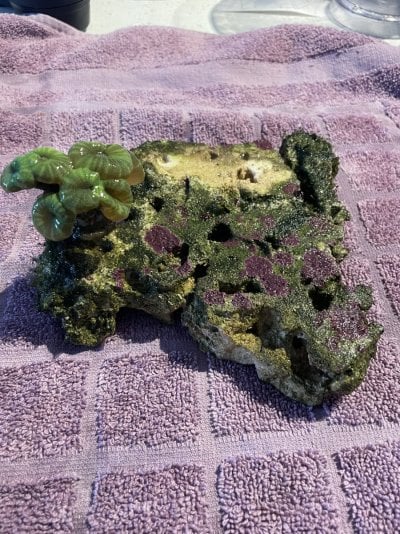
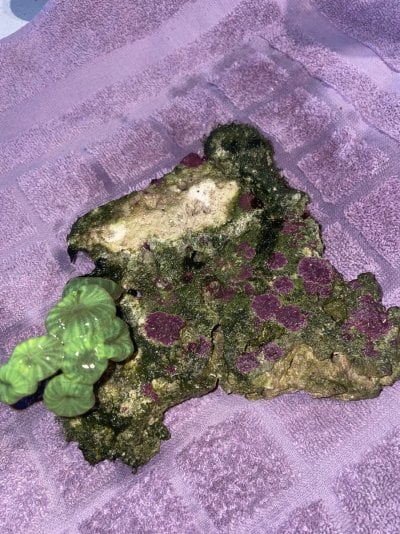
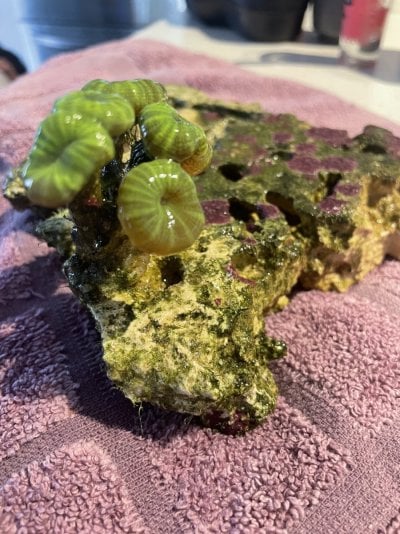
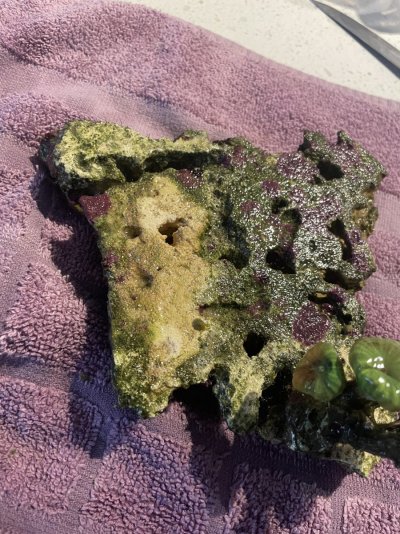
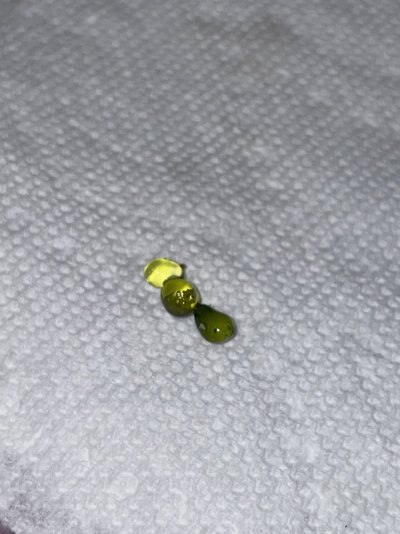
Last edited:
thank you so much for posting that, we absolutely needed to see rasping example pics.
*this is reef dentistry isn't it, literally that's a tooth laying on the counter. you're detailing the enamel areas, to reduce attachments unwanted, and you're avoiding the gumline (coral flesh) and you're not starting off with brushing, because that doesn't remove plaque only the sharp pointer angle tool from the dentist removes plaque
it always struck me how much of an analogue this thread is between reefing and surgery/dentistry for veterinary purposes. the reef tank is literally like a big mouth full of organic pocketing and decay off in the crevices which is dangerous (to the organisms inside) when that waste and decay isn't removed in the right order of ops.
animals are supposed to be our dentists, but they rarely complete the job/this is the trick for infinite reef tank lifespan control...physical detailing of surfaces and occasional sandbed flushing has produced the oldest running pico reef on the planet/the reefbowl/ and the exact same procedures can impart lifespan to large tank owners either preemptively or by reaction when needed, or during tank upgrades etc.
thanks so much for posting what a helpful opening volley these series of posts were from u
B
*this is reef dentistry isn't it, literally that's a tooth laying on the counter. you're detailing the enamel areas, to reduce attachments unwanted, and you're avoiding the gumline (coral flesh) and you're not starting off with brushing, because that doesn't remove plaque only the sharp pointer angle tool from the dentist removes plaque
it always struck me how much of an analogue this thread is between reefing and surgery/dentistry for veterinary purposes. the reef tank is literally like a big mouth full of organic pocketing and decay off in the crevices which is dangerous (to the organisms inside) when that waste and decay isn't removed in the right order of ops.
animals are supposed to be our dentists, but they rarely complete the job/this is the trick for infinite reef tank lifespan control...physical detailing of surfaces and occasional sandbed flushing has produced the oldest running pico reef on the planet/the reefbowl/ and the exact same procedures can impart lifespan to large tank owners either preemptively or by reaction when needed, or during tank upgrades etc.
thanks so much for posting what a helpful opening volley these series of posts were from u
B
I will agree that it does very much feel like dentistry, not that I know much that either but I’ve been to the dentist enough to guess lolthank you so much for posting that, we absolutely needed to see rasping example pics.
*this is reef dentistry isn't it, literally that's a tooth laying on the counter. you're detailing the enamel areas, to reduce attachments unwanted, and you're avoiding the gumline (coral flesh) and you're not starting off with brushing, because that doesn't remove plaque only the sharp pointer angle tool from the dentist removes plaque
it always struck me how much of an analogue this thread is between reefing and surgery/dentistry for veterinary purposes. the reef tank is literally like a big mouth full of organic pocketing and decay off in the crevices which is dangerous (to the organisms inside) when that waste and decay isn't removed in the right order of ops.
animals are supposed to be our dentists, but they rarely complete the job/this is the trick for infinite reef tank lifespan control...physical detailing of surfaces and occasional sandbed flushing has produced the oldest running pico reef on the planet/the reefbowl/ and the exact same procedures can impart lifespan to large tank owners either preemptively or by reaction when needed, or during tank upgrades etc.
thanks so much for posting what a helpful opening volley these series of posts were from u
B
I will gather what I am missing to plumb the new setup, new dry rocks, some more sand and will start making a detailed plan this week of how to proceed for the move!
I will try and take pictures of how this thing goes, if it can help others why now! I’ve gathered so much information here in the last year I feel like it’s important to give back
@brandon429 I thought you were exaggerating… sorry for my language but ive been washing the same ******* 40lbs bag of salt for 3 hours now and the ******* water is still cloudy…. Cant believe people but that **** directly in their tanks.. kinda ticked its taking so long, kinda happy I’m not paying for water when i’m from
The process is the process, but I’m confident the protocol will work, so i’ll put in the necessary work!
Will keep updating! Cheers
The process is the process, but I’m confident the protocol will work, so i’ll put in the necessary work!
Will keep updating! Cheers
I think it’s been a year since I’ve been in this board, and this is the first thread I see when I come backthank you so much for posting that, we absolutely needed to see rasping example pics.
*this is reef dentistry isn't it, literally that's a tooth laying on the counter. you're detailing the enamel areas, to reduce attachments unwanted, and you're avoiding the gumline (coral flesh) and you're not starting off with brushing, because that doesn't remove plaque only the sharp pointer angle tool from the dentist removes plaque
it always struck me how much of an analogue this thread is between reefing and surgery/dentistry for veterinary purposes. the reef tank is literally like a big mouth full of organic pocketing and decay off in the crevices which is dangerous (to the organisms inside) when that waste and decay isn't removed in the right order of ops.
animals are supposed to be our dentists, but they rarely complete the job/this is the trick for infinite reef tank lifespan control...physical detailing of surfaces and occasional sandbed flushing has produced the oldest running pico reef on the planet/the reefbowl/ and the exact same procedures can impart lifespan to large tank owners either preemptively or by reaction when needed, or during tank upgrades etc.
thanks so much for posting what a helpful opening volley these series of posts were from u
B
Funny you mention the dentistry angle…my wife is a dental hygienist, and I have a huge arsenal of dental equipment (scalers, periodontal probes, etc) in my kit. Nothing that grows on a rock is safe from me.
I’m not even afraid of putting star polyps in tanks, because as soon as they start to grow beyond where I want them, out come the scalers. And you should see how quickly I can clear 20 aptasias off a rock.
Gregg the hobby just does not get it regarding aiptasia
they're in the top three easiest pests to control
but the masses don't educate each other with the way that works/excision + scoring the foot off the rock by manforce right at the start where there's only 1 or 2
they only trade in hopes and wants: injections, animals (disease vectors) and pastes, and things that spread the aiptasia all over the tank. the masses deal in half actions
they simply will not, even after asking for help in aiptasia wreck posts, perform the excision process and kill aiptasia in one pass, they're literally frozen into inaction it's fascinating psychology.
here's an example of decisive action on felonious anemones:

 www.reef2reef.com
www.reef2reef.com
any reader on the site: post your aiptasia challenges here. instantly remove the excuse "I can't remove my rocks" because that's patently untrue. any reefer in the entire world can remove their rocks when properly incented. in this case, we'll save your reef tank from a harmless little anemone that fells thousands of tanks
they're in the top three easiest pests to control
but the masses don't educate each other with the way that works/excision + scoring the foot off the rock by manforce right at the start where there's only 1 or 2
they only trade in hopes and wants: injections, animals (disease vectors) and pastes, and things that spread the aiptasia all over the tank. the masses deal in half actions
they simply will not, even after asking for help in aiptasia wreck posts, perform the excision process and kill aiptasia in one pass, they're literally frozen into inaction it's fascinating psychology.
here's an example of decisive action on felonious anemones:

Build Thread - JD's 90 gallon mixed reef
*90 gallon mixed reef* Ruby Trigger 36 sump Reef Octopus 150 skimmer 2- EcoTech Radion XR15 pro Kessil H80 Refugium Light EcoTech Vectra return pump Icecap gyre Lifeguard media reactor This tank has been up and running for almost 4 years now. Its gone through some periods of neglect as other...
 www.reef2reef.com
www.reef2reef.com
any reader on the site: post your aiptasia challenges here. instantly remove the excuse "I can't remove my rocks" because that's patently untrue. any reefer in the entire world can remove their rocks when properly incented. in this case, we'll save your reef tank from a harmless little anemone that fells thousands of tanks
Last edited:
Four hours on 20lb bag of sand. It rough for sure.
@brandon429
I have a few questions bro. I'm replacing my max e170 with the same tank, just pulling old one off and dropping me one back on the stand. So I figure I may as well rip clean the rocks and put in new sand.
1) What's the best way to rinse me sand with RO water and how well do you rinse it.
2) I have a rock full of zoas with GHA in them. Would you dip the whole rock in H2O2?
3)When scrapping and rasping algae off rocks with corals on them, how long do you keep the rock out the water? Do you give the corals a break and put them back in the holding container?
4) I might even pull out a rock or two and scrape clean a few days before transfer day. Or should I do it all at once?
I apologize if some of these answers are already in the 59 pages of this thread.
Thanks bro
@brandon429
I have a few questions bro. I'm replacing my max e170 with the same tank, just pulling old one off and dropping me one back on the stand. So I figure I may as well rip clean the rocks and put in new sand.
1) What's the best way to rinse me sand with RO water and how well do you rinse it.
2) I have a rock full of zoas with GHA in them. Would you dip the whole rock in H2O2?
3)When scrapping and rasping algae off rocks with corals on them, how long do you keep the rock out the water? Do you give the corals a break and put them back in the holding container?
4) I might even pull out a rock or two and scrape clean a few days before transfer day. Or should I do it all at once?
I apologize if some of these answers are already in the 59 pages of this thread.
Thanks bro
thank you so much for posting that, we absolutely needed to see rasping example pics.
*this is reef dentistry isn't it, literally that's a tooth laying on the counter. you're detailing the enamel areas, to reduce attachments unwanted, and you're avoiding the gumline (coral flesh) and you're not starting off with brushing, because that doesn't remove plaque only the sharp pointer angle tool from the dentist removes plaque
it always struck me how much of an analogue this thread is between reefing and surgery/dentistry for veterinary purposes. the reef tank is literally like a big mouth full of organic pocketing and decay off in the crevices which is dangerous (to the organisms inside) when that waste and decay isn't removed in the right order of ops.
animals are supposed to be our dentists, but they rarely complete the job/this is the trick for infinite reef tank lifespan control...physical detailing of surfaces and occasional sandbed flushing has produced the oldest running pico reef on the planet/the reefbowl/ and the exact same procedures can impart lifespan to large tank owners either preemptively or by reaction when needed, or during tank upgrades etc.
thanks so much for posting what a helpful opening volley these series of posts were from u
B
@brandon429
I finally got around doing my transfer! I slowly dis my rocks and kept the clean ones in one corner of my 90g cube that I had. Rinsed my 40lbs bag of new sand for about 4 hours. Even had about 20-30lbs of used sand that someone just gave me right out of their tank that I rinsed in tap water for probablY around 1hr.
The whole transfer process took me just about 12 hours total by myself.
- pulled fish and inverts and corals and put them in a 16g rimless that I had sitting on the side with a powerhead and a heater
- emptied all 90% of the water trying not to disturb the sand
- pulled all my rocks out and layed them on a table.
- put all the sand in the new 135g
- started scaping my rocks, I had bought a bunch of acrylic rods and used a hammer drill to attach rocks together in a way I could disassemble later in needed (dont find that epoxy actually glues well on wet rock, IMO at least)
- pullet my sump from underneath my 90 and installed under the 135 (realized its too small so i’m getting a new one asap)
- filled all the water that I hadnt used to rinse the new sand etc in saltwater (making sure to empty my buckers slowly on top of big rocks on my scape not to disturb the new sand at all)
-finally added all the fish and invers and corals back in the tank when the temp was acceptable (not perfect but acceptable)
It was 9pm at that point I was up since 5am so I was completely gased out..
Anyway your method is THE method to do the transfer. I’ll attach a few pictures, that was monday, so 5 days ago, not one casualty (maybe some inverts but what do I care for a 3$ snail honestly)
The water wasnt 100% clear right after the transfer, but I ran it through the sump for about 1 hr with a filter sock. And before I was in bed the water was crystal clear!
Still waiting for my 3x radion xr15 to come in the mail so i’ve been fooling around with my old light moving it from side to side. But everything went A1, except the water all over the floor and my girlfriend looking at me like im a crazy
The last pic if from today, just to show how clean the water is still
Thank you for this thread, its what gave me the confidence to attempt this! Sold my old tank in 3 hours after that.
Now my gf is the first one to tell me it feels empty that we need to buy more fish/corals. I guess crazys get along
Cheers
Felix
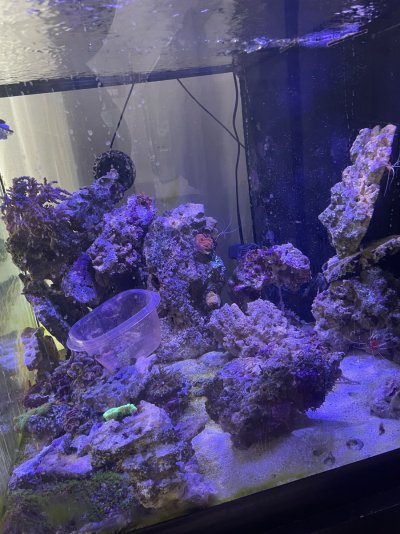
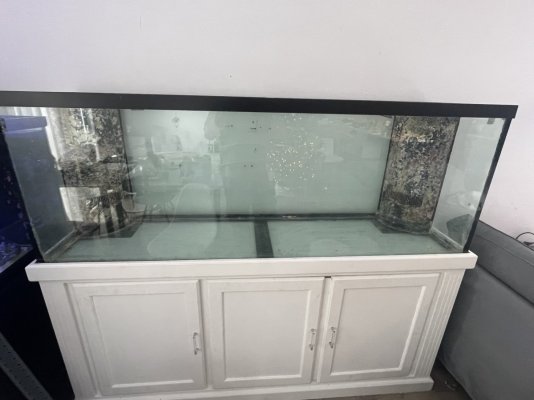
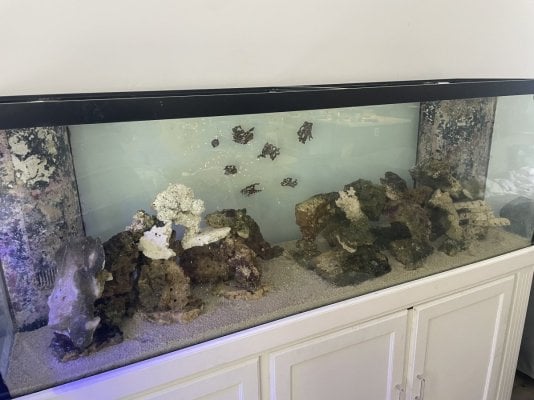
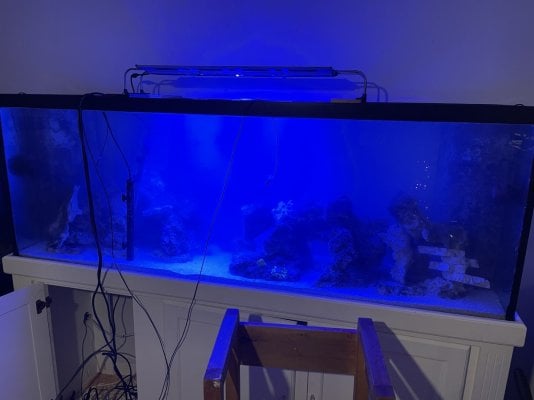
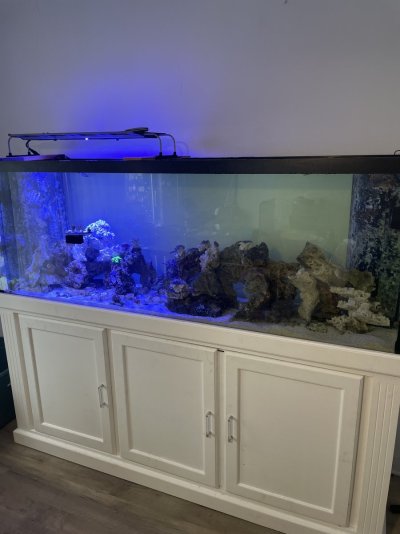
Last edited:
I’m so happy with that laser clear transfer pic set, so helpful for other movers planning large tank work
you didn’t use any bottle bac, right?
it’s so helpful to see that all reef tank cycles are linked in predictable, exact control since we are all dealing in stacks of rock in a display
that final arrangement, if done cloudless like you did, will transfer skip cycle any reef tank we can see it in the patterns
by not using bottle bac here we show that wet rocks will do just fine in retaining all needed bacteria + ammonia- consuming animals
you didn’t use any bottle bac, right?
it’s so helpful to see that all reef tank cycles are linked in predictable, exact control since we are all dealing in stacks of rock in a display
that final arrangement, if done cloudless like you did, will transfer skip cycle any reef tank we can see it in the patterns
by not using bottle bac here we show that wet rocks will do just fine in retaining all needed bacteria + ammonia- consuming animals
Last edited:
Similar threads
- Replies
- 1
- Views
- 59
- Replies
- 2
- Views
- 83
- Replies
- 26
- Views
- 1,189






